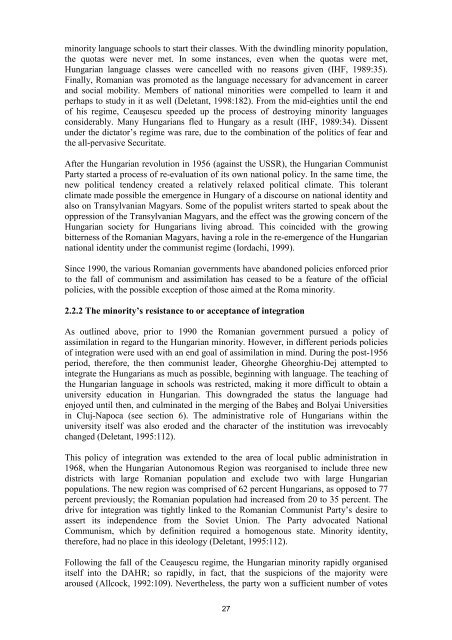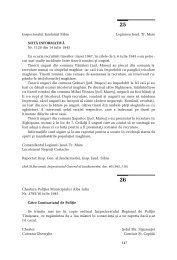Southeast Europe
Southeast Europe
Southeast Europe
You also want an ePaper? Increase the reach of your titles
YUMPU automatically turns print PDFs into web optimized ePapers that Google loves.
minority language schools to start their classes. With the dwindling minority population,<br />
the quotas were never met. In some instances, even when the quotas were met,<br />
Hungarian language classes were cancelled with no reasons given (IHF, 1989:35).<br />
Finally, Romanian was promoted as the language necessary for advancement in career<br />
and social mobility. Members of national minorities were compelled to learn it and<br />
perhaps to study in it as well (Deletant, 1998:182). From the mid-eighties until the end<br />
of his regime, Ceauşescu speeded up the process of destroying minority languages<br />
considerably. Many Hungarians fled to Hungary as a result (IHF, 1989:34). Dissent<br />
under the dictator’s regime was rare, due to the combination of the politics of fear and<br />
the all-pervasive Securitate.<br />
After the Hungarian revolution in 1956 (against the USSR), the Hungarian Communist<br />
Party started a process of re-evaluation of its own national policy. In the same time, the<br />
new political tendency created a relatively relaxed political climate. This tolerant<br />
climate made possible the emergence in Hungary of a discourse on national identity and<br />
also on Transylvanian Magyars. Some of the populist writers started to speak about the<br />
oppression of the Transylvanian Magyars, and the effect was the growing concern of the<br />
Hungarian society for Hungarians living abroad. This coincided with the growing<br />
bitterness of the Romanian Magyars, having a role in the re-emergence of the Hungarian<br />
national identity under the communist regime (Iordachi, 1999).<br />
Since 1990, the various Romanian governments have abandoned policies enforced prior<br />
to the fall of communism and assimilation has ceased to be a feature of the official<br />
policies, with the possible exception of those aimed at the Roma minority.<br />
2.2.2 The minority’s resistance to or acceptance of integration<br />
As outlined above, prior to 1990 the Romanian government pursued a policy of<br />
assimilation in regard to the Hungarian minority. However, in different periods policies<br />
of integration were used with an end goal of assimilation in mind. During the post-1956<br />
period, therefore, the then communist leader, Gheorghe Gheorghiu-Dej attempted to<br />
integrate the Hungarians as much as possible, beginning with language. The teaching of<br />
the Hungarian language in schools was restricted, making it more difficult to obtain a<br />
university education in Hungarian. This downgraded the status the language had<br />
enjoyed until then, and culminated in the merging of the Babeş and Bolyai Universities<br />
in Cluj-Napoca (see section 6). The administrative role of Hungarians within the<br />
university itself was also eroded and the character of the institution was irrevocably<br />
changed (Deletant, 1995:112).<br />
This policy of integration was extended to the area of local public administration in<br />
1968, when the Hungarian Autonomous Region was reorganised to include three new<br />
districts with large Romanian population and exclude two with large Hungarian<br />
populations. The new region was comprised of 62 percent Hungarians, as opposed to 77<br />
percent previously; the Romanian population had increased from 20 to 35 percent. The<br />
drive for integration was tightly linked to the Romanian Communist Party’s desire to<br />
assert its independence from the Soviet Union. The Party advocated National<br />
Communism, which by definition required a homogenous state. Minority identity,<br />
therefore, had no place in this ideology (Deletant, 1995:112).<br />
Following the fall of the Ceauşescu regime, the Hungarian minority rapidly organised<br />
itself into the DAHR; so rapidly, in fact, that the suspicions of the majority were<br />
aroused (Allcock, 1992:109). Nevertheless, the party won a sufficient number of votes<br />
27









